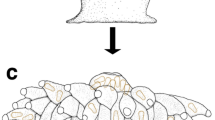Abstract.
Increases in ambient water temperature on coral reefs around the world, along with regional nutrient enrichment, have been a growing concern in coral reef ecology. We studied the effects of seawater temperature and ammonium concentrations on the azooxanthellate planular larvae of Diploria strigosa Dana, 1846 (Cnidaria: Scleractinia) over a period of 9 days. We did this to determine whether increases in these environmental variables affect coral larval development and survival. Settlement frequencies were also examined. Larvae were placed in water baths at 28°C, 30°C, and 32°C (ambient temperature at time of sampling was ~29°C). Larvae in 30°C and 32°C suffered approximately 50% and 70% greater mortality, respectively, than those at 28°C. At each of the three temperatures, separate groups of larvae were exposed to a 20 µM l–1 concentration of NH4 + (as NH4Cl), a concentration similar to that measured on certain reefs in the Florida Keys. Seawater temperatures of 30–32°C slowed or halted development in the later stages of larval development. At 32°C, time spent by larvae in a swimming/searching mode was observed to be higher than that at 28°C or 30°C. In the 28°C and 30°C treatments, D. strigosa planulae exhibited phototactic responses similar to those of other scleractinian corals – positively phototactic initially and then negatively so after ≥50 h; at seawater temperatures of 32°C, planulae became immediately negatively phototactic. In general, an increase in the seawater temperature caused a significant decrease in ciliary activity (motility) and rate of settlement in the larvae in a manner proportional to temperature. The presence of ammonium also caused a significant decrease in these variables, and these effects were additive with respect to those of increased temperature. The lack of symbiotic algae (which can assimilate ammonia) may have contributed to the observed increased mortality levels under conditions of enriched NH4 +. Calculation of isochrons (distances which a larva may traverse within a given period of time) for planulae exposed to conditions of increased temperature and/or ammonium concentrations suggests that a resultant decrease in larval longevity could potentially decrease distance of larval dispersal.
Similar content being viewed by others
Author information
Authors and Affiliations
Additional information
Electronic Publication
Rights and permissions
About this article
Cite this article
Bassim, .K., Sammarco, .P. Effects of temperature and ammonium on larval development and survivorship in a scleractinian coral (Diploria strigosa). Marine Biology 142, 241–252 (2003). https://doi.org/10.1007/s00227-002-0953-z
Received:
Accepted:
Issue Date:
DOI: https://doi.org/10.1007/s00227-002-0953-z




